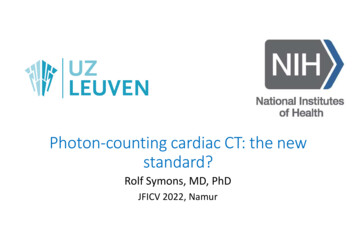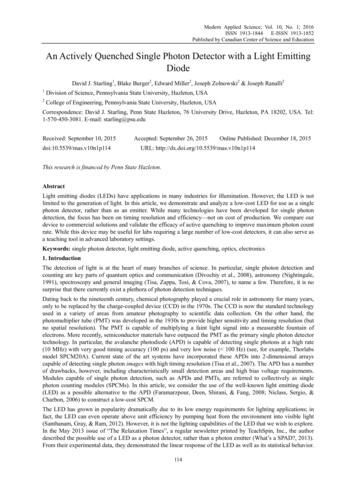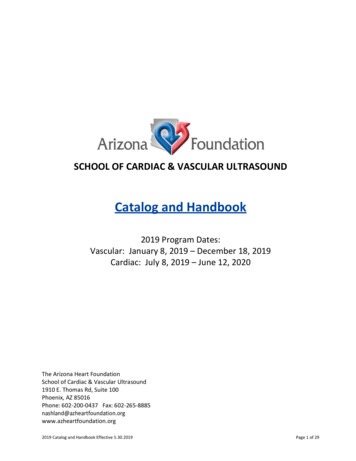
Transcription
Photon-counting cardiac CT: the newstandard?Rolf Symons, MD, PhDJFICV 2022, Namur
Disclosures Funded by the NIH intramural research program NIH research agreement with Siemens Healthineers Speaker fees from Siemens Healthineers
Physical principlesProof-of-concept studiesCurrent statusFuture directions
Physical principlesProof-of-concept studiesCurrent statusFuture directions
Detector technology comparison Energy-Integrating Detectors (EIDs) X-ray photon - light - electric signal (slow)Willemink MJ, et al. Photon-counting CT: technical principles and clinical prospects. Radiology. 2018 Nov 1;289(2):293-312.
Detector technology comparison Energy-Integrating Detectors (EIDs) X-ray photon - light - electric signal (slow) Photon-counting detectors (PCDs) X-ray photon - electric signal (fast)Willemink MJ, et al. Photon-counting CT: technical principles and clinical prospects. Radiology. 2018 Nov 1;289(2):293-312.
Detector technology comparison Energy-Integrating Detectors (EIDs) Photon-counting detectors (PCDs) X-ray photon - electric signal (fast) Measure number of photons (counts) andenergies separately (faster integration time) Photons divided into energy bins Equal weighting of low and high energy photons Spectral information retainedE bin 4IntensityPulse HeightPulse Height X-ray photon - light - electric signal (slow) Combine effects of energy and number ofphotons in intensity value Low weighting of low energy photons; highweighting of high energy photons Loss of spectral informationE4E bin 3E bin 2E3E2E bin 1E1TimeTime
lImageresolution contrastPulse HeightE bin 4E4E bin 3E3E bin 2E bin 1E2E1Time
Spectral information X-ray photons divided into multiple bins based on their energy(“energy bins”)Pulse Height e.g.: energy thresholds for a 140 kVp scan set at 25 keV and 75 keV: Images from all detected photons (25-140 keV) ( EID) Additionally, low (25-75 keV) and high (75-140 keV) energy images forspectral decomposition (similar to conventional dual-energy CT)highE4all75 keVE3lowE225 keVE1Time
Spectral information X-ray photons divided into multiple bins based on their energy(“energy bins”) e.g.: energy thresholds for a 140 kVp scan set at 25 keV and 75 keV: Images from all detected photons (25-140 keV) ( EID) Additionally, low (25-75 keV) and high (75-140 keV) energy images forspectral decomposition (similar to conventional dual-energy CT)25-140 keVPCD image using all detected photons25-75 keV75-140 keVLow energy bin High energy bin
Advantages over current dual-energy CTDual X-ray sourceFast kVp switching Dual-layer detectorLam et al.Cancers (2015)- Scattered radiation- Relatively high overlap of- Loss of high temporalthe energy spectraresolution when used in - Noise level may differdual-energy modebetween low and highenergy images- Relatively high overlap ofthe energy spectra- Fixed thresholds
Advantages over current dual-energy CT Spectral information always available - no special protocolrequired Less overlap between low and high energy data - bettermaterial separation Energy thresholds can be adapted to clinical indication - moreflexible
Advantages over current dual-energy CT Spectral information always available - no special protocolrequired Less overlap between low and high energy data - bettermaterial separation Energy thresholds can be adapted to clinical indication - moreflexible 2 energies possible - potential for multi-contrast imaging
More than dual-energy X-ray photons divided into multiple bins based on their energy(“energy bins”) e.g.: energy thresholds for a 140 kVp scan set at 25 keV, 50 keV, 75 keV, and90 keV: Images from all detected photons (25-140 keV) ( EID) Additionally, low1 (25-50 keV), low2 (50-75 keV), high1 (75-90 keV), andhigh2 (90-140 keV) energy imagesPulse Heighthigh290keV75 keV50 keV25 keVE4E3E2E1Timehigh1low2low1all
Symons R, et al. Dual-contrast agent photon-counting computed tomography of the heart: initialexperience. The international journal of cardiovascular imaging. 2017 Aug;33(8):1253-61.
Spectral information Based on the different attenuation of materials at different photonenergies (mostly related to the photoelectric effect)Danad I, et al. New applications of cardiac computed tomography: dual-energy, spectral, andmolecular CT imaging. JACC: Cardiovascular Imaging. 2015 Jun;8(6):710-23.
Spectral information 2D matrix 4D matrix 2 material differentiation 4 material differentiationBin HU values4 x 1 vectorProjection matrix4 x 4 matrixMaterialconcentrations(mM) 4 x 1 vector
lImageresolution contrastPulse HeightE bin 4E4E bin 3E3E bin 2E bin 1E2E1Time
Image contrast Elimination of electronic noise by lowest thresholdPulse HeightE bin 4E4E bin 3E3E bin 2E bin 1E2E1‘Low dose’ imagingTimeWillemink MJ, et al. Photon-counting CT: technical principles and clinical prospects. Radiology. 2018 Nov 1;289(2):293-312.
Image contrastPulse)Height Elimination of electronic noise by lowest threshold Higher weight to low-energy photons (better soft tissue contrast)IntensityTimeDanad I, et al. New applications of cardiac computed tomography: dual-energy, spectral, andmolecular CT imaging. JACC: Cardiovascular Imaging. 2015 Jun;8(6):710-23.
Image contrast Elimination of electronic noise by lowest threshold Higher weight to low-energy photons (better soft tissue contrast) Choosing energy bins to optimize contrastDanad I, et al. New applications of cardiac computed tomography: dual-energy, spectral, andmolecular CT imaging. JACC: Cardiovascular Imaging. 2015 Jun;8(6):710-23.
lImageresolution contrastPulse HeightE bin 4E4E bin 3E3E bin 2E bin 1E2E1Time
High resolution CT Energy-Integrating Detectors (EIDs) Optically isolating septa (to avoid opticalcross-talk) Smaller pixels more difficult to make Dose efficiency with smaller pixels Photon-counting detectors (PCDs) No optically isolating septa Smaller pixels are needed to avoid pulse pile-up Dose efficiency with smaller pixelsDETECTORWillemink MJ, et al. Photon-counting CT: technical principles and clinical prospects. Radiology. 2018 Nov 1;289(2):293-312.
High resolution CT Energy-Integrating Detectors (EIDs) Optically isolating septa (to avoid opticalcross-talk) Smaller pixels more difficult to make Dose efficiency with smaller pixels Photon-counting detectors (PCDs) No optically isolating septa Smaller pixels are needed to avoid pulse pile-up Dose efficiency with smaller pixelsDETECTORWillemink MJ, et al. Photon-counting CT: technical principles and clinical prospects. Radiology. 2018 Nov 1;289(2):293-312.
Physical principlesProof-of-concept studiesCurrent statusFuture directions
Standard versus high resolution PCD Each PCD pixel consists of sixteen(4x4) subpixels: Standard resolution: 4x4 binningof subpixels, 0.40 mm effectivepixel size at isocenter High resolution: 2x2 binning ofsubpixels, 0.20 mm effective pixelsize at isocenter Line-pairs of Catphan CT phantom: Standard resolution: 9 LP/cm High resolution: 18DETECTORLP/cmPourmorteza A, et al. Dose efficiency of quarter-millimeter photon-counting computed tomography: first-in-human results. Investigative radiology. 2018 Jun 1;53(6):365-72.
High resolution CAC score Less blooming Sharper edgesImages property of NIH
High resolution CAC score Less blooming Sharper edges More accuratecoronary stenosisquantificationImages property of NIH
Low dose CAC score At lower doses, PCD CAC scoresshow superior accuracy andreproducibility versus EIDSymons R, et al. Coronary artery calcium scoring with photon-counting CT: first in vivo human experience. The international journal of cardiovascular imaging. 2019 Apr;35(4):733-9.
High resolutioncoronary stentimaging Example axial (A), coronal(B), and coronalmaximum intensityprojection (MIP)reconstructions (C) of acoronary stent with 2.75mm nominal diameterSymons R, et al. Quarter-millimeter spectral coronary stent imaging with photon-counting CT: initial experience. JCCT. 2018 Nov 1;12(6):509-15.
Virtual monochromatic imaging40 keV 50 keV 60 keV 70 keV 80 keV 90 keV 100 keV 110 keV120 keV 130 keV 140 keV
Reduced image artifacts Radiation dose-matched EID and PCD contrast-enhanced head andneck scansEIDPCDSymons R, et al. Photon-counting CT for vascular imaging of the head and neck: first in vivo human results. Investigative radiology. 2018 Mar;53(3):135.
Physical principlesProof-of-concept studiesCurrent statusFuture directions
First photon-counting CT approved for clinical use (Siemens NAEOTOM Alpha) Prototypes from other manufacturers are in advanced stages of development
First photon-counting CT approved for clinical use (Siemens NAEOTOM Alpha) Prototypes from other manufacturers are in advanced stages of development
First human CCTA studiesPCDEID Prototype PCCT (Philips) 14 patients PCD vs dual-layer EID CCTA PCD: 1024x1024 matrix, 64 x 0.275 mmcollimation, 0.25 mm section thickness EID: 512x512 matrix, 64 x 0.625 mmcollimation, 0.67 mm section thickness PCCT improved image quality anddiagnostic confidence compared with EIDSi-Mohamed SA, Boccalini S., et al. Coronary CT angiography with photon-counting CT: first-in-human results. Radiology. 2022 May;303(2):303-13.
First human CCTA studies Clinical PCCT (Siemens) 20 patients PCD PCD: 1024x1024 and 512x512 matrix, 120x 0.2 mm collimation, 0.2 mm sectionthickness Different reconstruction kernels PCCT CCTA is feasible and enables thevisualization of calcified coronaries withan excellent image quality, highsharpness, and reduced blooming.Mergen V, et al. Ultra-High-Resolution Coronary CT Angiography With Photon-Counting Detector CT: Feasibility and Image Characterization. Investigative Radiology.:10-97.
First human CCTA studiesWithout Pure LumenWith Pure LumenCourtesy of University Hospital Augsburg, Augsburg, Germany
First human CCTA studies0.4 x 0.4 mm0.4 x 0.4 mmPure Lumen0.2 x 0.2 mmCourtesy of University Hospitals Leuven, Leuven, Belgium
Limitations First clinical studies suggest improvements in subjective and objectiveimage quality Further studies needed: Accuracy (vs ICA /- IVUS/OCT) Radiation dose Patient outcome
Physical principlesProof-of-concept studiesCurrent statusFuture directions
Coronary plaque composition Better spatial and contrast resolution more accurate plaque characterization Better detection of ‘vulnerable plaques’Maurovich-Horvat P, et al. Comprehensive plaque assessment by coronary CT angiography. Nature Reviews Cardiology. 2014 Jul;11(7):390-402.
Coronary plaque composition (2) Although MRI and PET are usefulfor imaging arteries such as theaorta and carotid arteries, the longimage acquisition times makeimaging of the coronary arteriesvery challenging Au labeled HDL particlesaccumulate in inflammatoryplaques with high macrophagecontent Photon-counting CT allows fordetection of both intravascular Iand intraplaque Au particlesSi-Mohamed SA, et al. In Vivo Molecular K-Edge Imaging of Atherosclerotic Plaque Using Photon-counting CT. Radiology. 2021 May 4:203968.
Coronary plaque burden Better spatial and contrast resolution more accurate delineation of inner and outercoronary wall More accurate quantification of totalcoronary plaque burden Nonobstructive CAD, when extensive, may beassociated with risk of myocardial infarctionand cardiac death similar to obstructivediseaseSymons R, et al. CCTA: variability of CT scanners and readers in measurement of plaque volume. Radiology. 2016 Dec;281(3):737-48.
Coronary plaque burden (2) Detection of nonobstructive CAD with CT in stable chest pain resulted in asignificantly lower rate of death at 5 years vs standard care, without resulting ina higher rate of coronary angiography or coronary revascularization.SCOT-Heart Investigators. Coronary CT angiography and 5-year risk of myocardial infarction. New England Journal of Medicine. 2018 Sep 6;379(10):924-33.
CT FFRIn theory more accurate with photon-counting CT, but algorithms need to be adaptedLu MT, et al. Noninvasive FFR derived CCTA: management and outcomes in the PROMISE trial. JACCi. 2017 Nov;10(11):1350-8.
CT perfusionIn theory more accurate with photon-counting CT, but algorithms need to be adaptedAndreini D, et al. CT perfusion versus CCTA in patients with suspected in-stent restenosis or CAD progression. JACCi. 2020 Mar 1;13(3):732-42.
Cine CTWall thickening (%) Lower radiation dose may allow for more comprehensive CT scanning duringthe entire cardiac cycle
Myocardial tissue characterizationAB(a) CT-derived extracellular volume (ECV) and (b) cardiac MRI-derived ECV in a 56-year-old woman withhypertrophic cardiomyopathy. CT may allow for detection of first pass perfusion, late enhancement,myocardial edema, and ECVOda S, et al. Myocardial late iodine enhancement and extracellular volume quantification with dual-layer spectraldetector dual-energy cardiac CT. Radiology: Cardiothoracic Imaging. 2019 Apr 25;1(1):e180003.
Multi-energy cardiac imaging Wild mongrel dogs with chronic myocardial infarction Late enhancement Gadolinium, first pass IodineGd injectionI injection10 minImaging20 secSymons R, et al. Dual-contrast agent photon-counting computed tomography of the heart: initialexperience. The international journal of cardiovascular imaging. 2017 Aug;33(8):1253-61.
Multi-energy cardiac imaging Wild mongrel dogs with chronic myocardial infarction Late enhancement Gadolinium, first pass Iodine Multiphase CT acquiredin a single acquisitionSymons R, et al. Dual-contrast agent photon-counting computedtomography of the heart: initial experience. The internationaljournal of cardiovascular imaging. 2017 Aug;33(8):1253-61.
Conclusion Photon-counting CT has important advantages over conventional CTdetector technology: High spatial resolution Lower image noise Spectral information Paradigm shift from qualitative to quantitative CT More than coronary stenosis assessment (coronary plaquecomposition/inflammation, function, myocardial tissuecharacterization, ) Further studies needed! Some practical issues still need to be solved (CT FFR, perfusionsoftware, )
Coronary CT
Cardiac CT
Thank you Jan Bogaert, MD, PhDSteven Dymarkowski, MD, PhDStefan Janssens, MD, PhDTom Dresselaers, PhD Hilde Bosmans, PhD Walter Coudyzer, MSc David A. Bluemke, MD, PhDAmir Pourmorteza, PhDVeit Sandfort, MDTyler E. Cork, MS
First human CCTA studies Si-Mohamed SA, BoccaliniS., et al. Coronary CT angiography with photon-counting CT: first-in-human results. Radiology. 2022 May;303(2):303-13. PCD EID Prototype PCCT (Philips) 14 patients PCD vs dual-layer EID CCTA PCD: 1024x1024 matrix, 64 x 0.275 mm collimation, 0.25 mm section thickness










